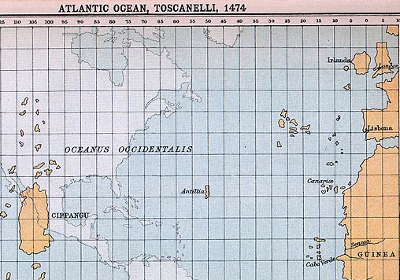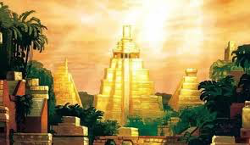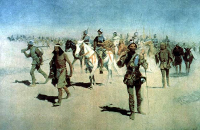The Seven Cities of Gold: Shiny Legendary Mirage
The Seven Cities of Gold was a mythic destination for many a New World treasure-seeker and fortune-hunter in the 16th Century. Said to be an oasis of riches in an otherwise barren land, they proved to be mirages. The fruitless pursuit of their location and their wealth consumed a few famous personalities. 
Cíbola was the most famous of the cities. Sometimes, the cities are referred to collectively as the Seven Cities of Cíbola. Some sources name the other cities as Halona, Hawikuh, Kiakima, Kwakina, Matsaki, and Quivira. One possible origin of the stories of these fabled cities full of riches was a legend in the Portuguese tradition of seven bishops, one of whom was the Archbishop of Porto, avoiding the tumult of the 8th-Century Muslim conquest of Portugal and Spain by sailing to the island of Antilia, in the Atlantic Ocean far to the west, and each founding a settlement there. The island was also known as the Isle of Seven Cities. The story of the bishops was associated with a similar story of King Don Rodrigo of Spain. Maps for much of the 15th Century featured Antilia; maps appearing after Christopher Columbus and others charted the Atlantic did not feature Antilia. 
Columbus traveled to South America on one of his later voyages. Portuguese explorers like Vasco Núñez de Balboa had been to South America as well. In the early 16th Century, Spanish soldiers were successful in conquering both the Aztec Empire and the Inca Empire and were looking for more wealth and riches in North America. From these conquered peoples, Spaniards heard stories fo rich cities far to the north. Some of those stories mentioned great, gleaming cities, filled with gold. Thus was the story of the Seven Cities transplanted to the New World. A Spanish expedition led by Pánfilo de Nárvaez to Florida in 1528 ended in disaster; only four people of the original 600 survived the shipwreck and straggled into Mexico years later, after surviving a period of captivity in the hands of Native Americans. One of the things that kept these survivors going was the promise of the gold-laden Seven Cities that they had heard about along the way. Antonio de Mendoza, the Viceroy of New Spain, dispatched a small group of people to find these fabled Seven Cities in 1539. One of those people was a survivor of the Nárvaez expedition named Álvar Núñez Cabeza da Vaca; another was Marcos de Niza, a Franciscan priest. The group searched high and low, finding no trace of cities overflowing with gold. Dorantes did not survive an encounter with hostile Native Americans. Marcos did survive and made it back to Mexico, where he reported having seen, in the distance, a very large city; fearful of meeting the same fate that Dorantes did, he stayed well clear of the city. 
Mendoza believed Marcos's story and sent a much larger group of people to find the fabled cities. Leading this expedition was Francisco Vásquez de Coronado. He and his force of 400 European soldiers and more than 1,300 Native Americans set out from Compostela on Feb. 23, 1540 and went through what is now Arizona, Arkansas, Colorado, Kansas, Missouri, New Mexico, Oklahoma, and Texas. One contingent, led by Hernando de Alarcón, went via the Guadalupe River; Coronado led the other force, which traveled on land. They all found rumors but nothing more: Cíbola was nothing more than a normal settlement. Most of his force returned to Mexico in 1541; Coronado and a much smaller forced carried on, eventually returning empty-handed in 1542. Coronado was off again, not too long afterward, convinced that if he just kept searching, he would find the golden horde. Trusting the word of a local guide, Coronado and another Spanish force again traversed what is now the Midwestern U.S. The story was that the capital city was called Quivira; they found that settlement in what is now Kansas but found none of the riches that were said to be there. Coronado claimed for Spain all of the land he explored. It was about the only benefit his explorations brought. As for the Seven Cities of Gold–if they ever existed–they remained a mystery. |
|
Social Studies for Kids
copyright 2002–2025
David White





